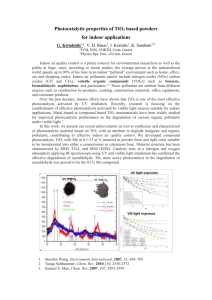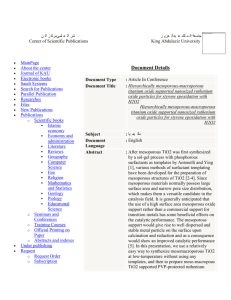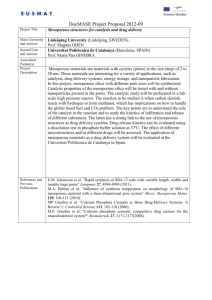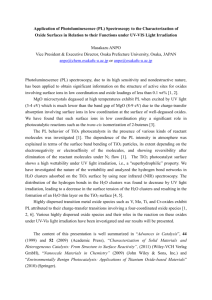MICROSTRUCTURE OF MESOPOROUS TiO2
advertisement
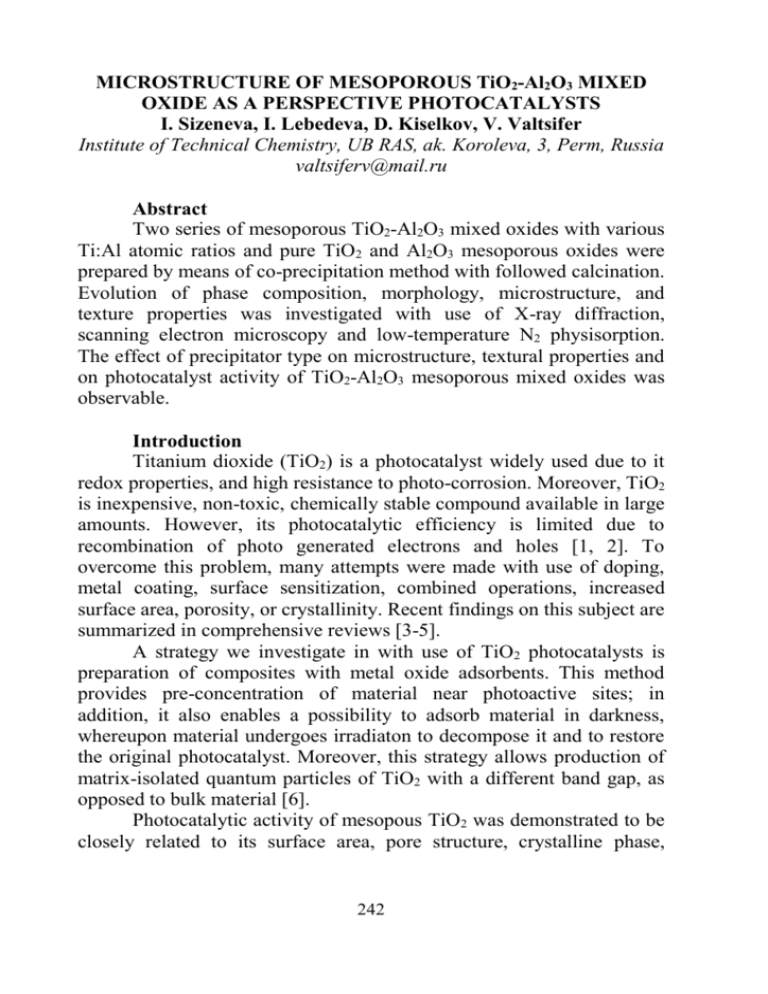
MICROSTRUCTURE OF MESOPOROUS TiO2-Al2O3 MIXED
OXIDE AS A PERSPECTIVE PHOTOCATALYSTS
I. Sizeneva, I. Lebedeva, D. Kiselkov, V. Valtsifer
Institute of Technical Chemistry, UB RAS, ak. Koroleva, 3, Perm, Russia
valtsiferv@mail.ru
Abstract
Two series of mesoporous TiO2-Al2O3 mixed oxides with various
Ti:Al atomic ratios and pure TiO2 and Al2O3 mesoporous oxides were
prepared by means of co-precipitation method with followed calcination.
Evolution of phase composition, morphology, microstructure, and
texture properties was investigated with use of X-ray diffraction,
scanning electron microscopy and low-temperature N2 physisorption.
The effect of precipitator type on microstructure, textural properties and
on photocatalyst activity of TiO2-Al2O3 mesoporous mixed oxides was
observable.
Introduction
Titanium dioxide (TiO2) is a photocatalyst widely used due to it
redox properties, and high resistance to photo-corrosion. Moreover, TiO2
is inexpensive, non-toxic, chemically stable compound available in large
amounts. However, its photocatalytic efficiency is limited due to
recombination of photo generated electrons and holes [1, 2]. To
overcome this problem, many attempts were made with use of doping,
metal coating, surface sensitization, combined operations, increased
surface area, porosity, or crystallinity. Recent findings on this subject are
summarized in comprehensive reviews [3-5].
A strategy we investigate in with use of TiO2 photocatalysts is
preparation of composites with metal oxide adsorbents. This method
provides pre-concentration of material near photoactive sites; in
addition, it also enables a possibility to adsorb material in darkness,
whereupon material undergoes irradiaton to decompose it and to restore
the original photocatalyst. Moreover, this strategy allows production of
matrix-isolated quantum particles of TiO2 with a different band gap, as
opposed to bulk material [6].
Photocatalytic activity of mesopous TiO2 was demonstrated to be
closely related to its surface area, pore structure, crystalline phase,
242
crystallinity, and particle size [7]. Thus, it is important to develop
methods controlling textural properties and crystal structure.
In the presented article, we report synthesis of mesoporous TiO2Al2O3 mixed oxides with various Ti:Al ratios by means of coprecipitation of TiOSO4 and Al2(SO4)3 with aqueous ammonia or urea.
Porous textures and crystalline structures of mesoporous TiO2-Al2O3
mixed oxides were controlled by means of variable Ti and Al atomic
ratios and precipitation conditions. Effect of the precipitator type and of
Ti:Al atomic ratio on microstructure, phase composition, textural
properties of mesoporous TiO2-Al2O3 mixed oxides was investigated.
Experimental part
All chemicals were analytic-grade reagents used without
subsequent purification. Mesoporous TiO2-Al2O3 composites with
various Ti:Al atomic ratios were prepared by means of co-precipitation
of a mixed solution of TiOSO4 and Al2(SO4)3 with use of aqueous
ammonia or urea as precipitation agent according to procedure described
in [8]. Unlike the mentioned method, TiOSO4 solution was used instead
of Ti(SO4)2 solution in the presented work. All composites were calcined
at 500 ˚C in air for 3 h. The resulting mesoporous TiO2-Al2O3 mixed
oxides are denoted as A-n-500 and M-n-500 for synthesis with aqueous
ammonia and urea, respectively. The n value varies from 1 to 5 for Ti:Al
atomic ratios varying from 0:1 to 1:0; 500 is calcination temperature, ˚C.
Crystalline phase of TiO2-Al2O3 samples was investigated with
use of X-ray diffraction (XRD) method (XRD-7000 diffractometer,
Shimadzu, Japan) using the CuKa-radiations (λ = 1.5406 Å) in the 2Θ
interval of 10-80. Average dimensions of crystallites were determined
with use of the Scherrer equation, D = 0.89λ/βcosθ, using (101)
reflection for anatase phase and (110) for TiO2-B phase. Here, D is
crystallite size, λ is the wavelength of X-ray radiation (1.5406 Å), 2θ is
the scattering angle and β is the full width at half maximum of the Bragg
reflection, after correction of instrumental broadening [1].
The shape and microstructure of TiO2-Al2O3 samples were
observed with use of scanning electron microscope (model XR-3000,
Evex, USA).
Isotherms of low-temperature nitrogen adsorption were registered
at -196 C by means of the ASAP 2020 device (Micrometrics, USA),
243
after degassing the material under vacuum at 350 C for 3 h. Specific
surface area (SBET) of samples was calculated as per the BET method in
0.05-0.25 p/p0 interval of relative pressure values. Total pore volume
(Vtot) was calculated from the quantity of nitrogen adsorbed at relative
pressure p/p0 0.99. Pore size distribution and average pore diameter
values were determined from desorption isotherms using the BJH
method.
Photocatalytic activity of TiO2-Al2O3 mesoporous composites
was appraised from degradation of salicylic acid (SA) under UV
radiation (luminescent lamp, 78 W, base line of spectrum 365 nm).
Magnetic stirring in darkness was exposed for 60 min. Degradation (X)
of salicylic acid was determined by means of absorbance measured at
298 nm with UV-vis spectrofotometer (PortLab 511).
Results and discussions
XRD patterns in Figure 1 illustrate crystalline phase of
mesoporous TiO2-Al2O3 mixed oxides with various Al:Ti atomic ratios.
As shown in Figure 1, the A-5-500, and M-5-500 samples (Ti:Al=1:0)
are pure anatase (ICDD No. 00-021-1272), whereas the A-3-500, M-3500 (Ti:Al = 1:1) and A-4-500, M-4-500 (Ti:Al = 9:1) samples consist
of both anatase and amorphous alumina. A peak at around 2θ = 25.0400
˚ corresponding to TiO2-B crystallite (ICDD No. 00-035-0088) [9] was
observed in A-4-500 sample. As is apparent from Figure 1, only sharp
diffraction peaks are observed for pure TiO2 samples (A-5-500 and M-5500). These peaks indicate precipitation with aqueous ammonia and urea
with subsequent calcination to completely crystallize the samples, no
matter which precipitator is used. The absence of peaks in XRD patterns
of the A-1-500, A-2-500, M-1-500, and M-2-500 sample confirms
amorphous structure of these samples.
Apparently, the type of precipitator and Al:Ti atomic ratio
influence the crystalline structure of TiO2 in TiO2-Al2O3 composites.
Relatively weak diffraction peaks of the A-3-500 (Al:Ti = 1:1) and A-4500 (Al:Ti = 1:9) samples indicate their low crystallinity. The well
crystallized anatase structure of samples M-3-500 and M-4-500 signifies
precipitation in homogenous conditions (with urea) to result in better
crystallinity, as compared with inhomogeneous conditions (using
ammonia).
244
Fig. 1. XRD patterns of mesoporous TiO2-Al2O3 mixed oxides. A: anatase; B:
TiO2-B crystalline phases of TiO2.
Average dimensions of crystallites of anatase and of TiO2-B
calculated in accord with the Sherrer equation are presented in Table 1.
As shown in Table 1, A-n-500 samples have larger anatase crystallites as
compared with M-n-500 samples. This is explained by the fact that
hydrolysis of urea proceeds slowly, thus limiting hydrolysis of titanium
and aluminum precursors. At this point, groups of unhydrolyzed anions
remain in precursors and prevent aggregation of particles by means of
electrostatic repulsion and growth of the TiO2 crystallites.
SEM images (Figure 2) show micro-scale morphologies of
mesoporous TiO2-Al2O3 mixed oxides (A-n-500 and M-n-500) markedly
differing from one another. As is apparent, A-n-500 samples have
fibrous structure of anatase, only some irregular aggregates presumably
composed of amorphous alumina can be observed on surface of
particles. Microphotograph of M-n-500 samples show porous
agglomerates, irregularly sized and shaped.
Nitrogen physisorption analysis provides detailed information on
pore texture. Specific surface area and total pore volume values for all
samples investigated are summarized in Table 1. As is apparent, surface
area value of A-n-500 samples increases, as Ti:Al atomic ratio increases,
245
being the largest for M-n-500 samples at Ti:Al= 1:1 atomic ratio. The
presence of TiO2 (anatase) in all samples leads to enhanced surface area.
Table 1. Crystalline structures and textural properties of mesoporous TiO 2Al2O3 mixed oxides
Sample
Al:
Ti
SBET,
m2g-1
Vtot,
cm3g-1
DBJH,
nm
A-1-500
A-2-500
A-3-500
A-4-500
1:0
9:1
1:1
1:9
97
96
199
269
0.153
0.130
0.406
0.287
3.4
3.5
3.8
≤2.5,
3.9
A-5-500
0:1
486
0.562
M-1-500
M-2-500
M-3-500
M-4-500
M-5-500
1:0
9:1
1:1
1:9
0:1
9
11
284
251
136
0.015
0.019
0.556
0.486
0.207
≤1.7,
3.7
2.4
3.4
7.6
5.9
5.0
Phase
composit
ion
amorph
anatase
anatase
anatase,
TiO2-B
Cryst
size, nm
anatase
9.8
15.5 (A),
36.6
(TiO2-B)
12.4
amorph
amorph
anatase
anatase
anatase
6.9
6.1
8.9
X
SA,
%
10
6
26
50
15
18
48
76
-
Fig. 2. SEM images of mesoporous TiO2-Al2O3 mixed oxides, 5.0x103
magnifications
246
Isotherms of nitrogen adsorption-desorption, and pore size
distribution patterns of mesoporous TiO2-Al2O3 mixed oxides are
presented in Figure 3. All isotherms are of IV type (IUPAC
classification) and indicate availability of mesoporous in samples.
However, as shown in Figure 3, isotherms of pure Al2O3 and of pure
TiO2 as well as of TiO2-Al2O3 composites prepared with use of a
different precipitation method differ markedly and evince different
textural properties in these samples. Moreover, isotherms of A-n-500
samples show H2-type hysteresis loop for pure Al2O3 samples and for
samples with small TiO2 percentage (A-1-500, A-2-500); a combination
of H2- and H3-types for samples with larger TiO2 percentage (A-3-500,
A-4-500), and H3-type hysteresis loop for pure TiO2 samples (anatase),
thus indicating differences in pore structure of these oxides.
Fig. 3. Isotherms of N2 adsorption-desorption and pore size distribution patterns
of mesoporous TiO2-Al2O3 mixed oxides.
A triangularly-shaped hysteresis loop with a steep desorption
branch belonging to H2-type hysteresis loop indicates availability of
247
pores with narrow mouth (ink-bottle pores). H3- type hysteresis loop is
attributed to aggregates of plate-like particles forming slit-like pores [1].
This phenomenon is confirmed by corresponding pore size distribution
calculated with use of the BJH method (Figure 3).
For M-3-500, M-4-500, M-5-500 samples, isotherms show H2type hysteresis loop in relative pressure interval exceeding 0.6. As is
apparent from pore size distribution patterns of these samples, pure TiO2
sample is characterized availability of narrow pore size distribution with
a peak centered at 5.0 nm, whereas TiO2-Al2O3 mixed oxides (M-4-500
and M-3-500) have a wider distribution centered at 5.9 and 7.6 nm,
respectively.
While comparing TiO2-Al2O3 samples prepared with use of
different precipitators, we had ascertained variations in synthesis
conditions to be reflected in phase composition and in textural properties
of samples and, therefore, in their catalytic activity. The measured
grades of photocatalytic decomposition of SA are shown in Table 1. The
samples with atomic ratio Ti:Al = 9:1 are more efficient photocatalysts.
This can be attributed to large surface area and pore volume in these
samples.
Conclusions
Mesoporous TiO2-Al2O3 mixed oxides were prepared by means
of co-precepitation method under homogenous and inhomogeneous
conditions. Their porous and crystalline structures were tailored with use
of variable type of precipitator and Ti:Al atomic ratios. Results show
evinidence that mesoporous TiO2-Al2O3 mixed oxides prepared under
homogenous conditions have fibrous structures of anatase with some
irregularly-shaped aggregates presumably composed of amorphous
Al2O3 on surface of TiO2 particles, whereas mesoporous TiO2-Al2O3
mixed oxides prepared under inhomogeneous conditions are porous
irregularly-shaped agglomerates. It has been ascertained that variations
in synthesis conditions are reflected in phase composition and in textural
properties of samples and, therefore, in its catalytic activity. Mesoporous
TiO2-Al2O3 mixed oxides with atomic ratio Ti:Al = 9:1 are more
efficient photocatalysts. This can be attributed to large surface area and
pore volume in these samples.
248
Acknowledgement
The reported study was partially supported by RFBR, research
project No. 13-03-96111 r_ural_a.
1.
2.
3.
4.
5.
6.
7.
8.
9.
References
Kaishening Xia, Dean Ferguson, Yahia Djaoued et al. Templatefree synthesis and photocatalytic activity of hierarchical porous
titania with controlled texture and crystalline structure. Applied
Catalysis A: General. 2010 387 231-241.
Maria-Veronica Sofianou, Maria Tassi, Nikos Boukos et al.
Solvothermal synthesis and photocatalytic performance of Mg2+doped anatase nanocrystals with exposed {001} facets. Catalysis
Today. 2014 230 125-130.
Bunsho Ohtani. Preparing Articles on photocatalysis – beyond
the illustrations, misconceptions, and speculation. Chemistry
Letters. 2008 37 217-229.
Ioannis K. Konstantinou, Triantafyllos A. Albanis. TiO2-assisted
photocatalytic degradation of azo dyes in aqueous solution:
kinetic and mechanistic investigations. A review. Applied
Catalysis B: Enviromental. 2004 49 1-14.
Harrison S. Kibombo, Rui Peng, Shivatharsiny Rasalingam and
Ranjit T. Koodali. Versality of heterogeneous photocatalysis:
synthetic methodologies epitomizing the role of silica support in
TiO2 based mixed oxides. Catal. Sci. Technol. 2012 2 1737-1766.
Carl Anderson and Allen J. Bard. Improved photocatalytic
activity and characterization of mixed TiO2/SiO2 and TiO2/Al2O3
materials. J. Phys. Chem. B. 1997 101 2611-2616.
M. Boulslama, M.C. Amamra, Z. Jia et al. Photocatalytic media:
effect of particle size and polymorphism on photocatalytic
activity. ACS Catal. 2012 2 1884-1892.
Elvira Rodenas, Tsutomu Yamaguchi, Hideshi Hattori and Kozo
Tanabe. Surface ans catalytic properties of TiO2-Al2O3. Journal
of catalysis. 1981 69 434-444.
Thomas P. Feist and Peter K. Davies. The soft synthesis of TiO2
(B) from layered titanates. Journal of solid state chemistry. 1992
101 275-295.
249
